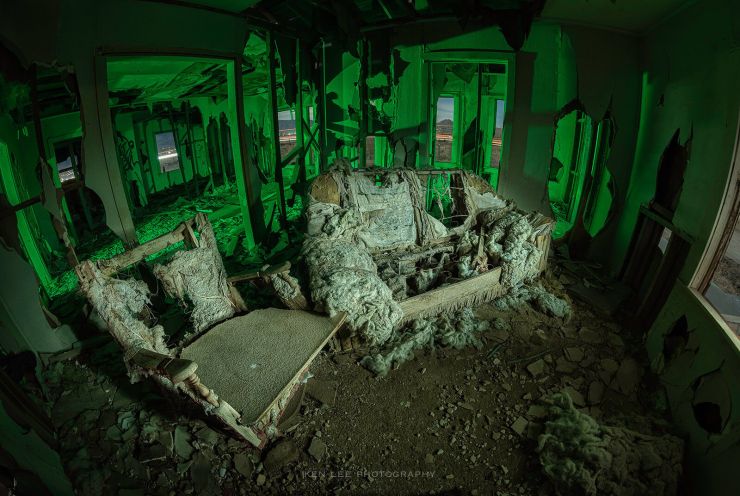I recently photographed an early 1900s abandoned farmhouse in the Mojave Desert with photographer Anthony Donofrio.
While exploring, I came across a living room with some extremely weathered sofa and rocking chair. The scene was busy, and I wanted the attention to be squarely on the furniture. However, I also wanted to use a fisheye to give broader context, tell a story, and look weirder. Here’s how I approached light painting the scene.

1. Highlighting the furniture
After beginning the exposure, I used a warm white light from a handheld ProtoMachines LED2 light painting device. To pick up some of the texture from the furniture, I illuminated it from the open window on the right hand side.
2. Differentiating the background from the subject
As I mentioned, I wanted to give a broader context, telling the story about where the furniture was. In other words, I wanted to photograph much of the house and even include some of the world outside. Of course, I also wanted to separate it so your attention would be directed to the furniture initially.
To do that, I decided to light paint the rest of the house a different color to offset it. I chose green, although I did do a version of this with red as well. To create drama through texture and create shadow, I lit the interior from two different angles from camera left and right to achieve this.
3. The world outside
To give additional context, I thought I would share some of the world outside. The farmhouse sits near the side of a road. I waited to begin the exposure until I saw some vehicles drawing near. The vehicles’ streaking lights provide additional context in telling the story of this abandoned scene.
4. Using a fisheye
I chose to use a Rokinon 12mm fisheye lens for this scene. I did this in part because I could include much of the house and the world beyond as well as to have the image look even more surreal. The green colors enhance the strangeness of the photo. I find that a fisheye can be a jolt of creativity, enabling me to present a perspective that we ordinarily don’t see.
Tell your story with the second annual Visual Storytelling Conference!
Experience four days of interactive, online training sessions featuring a range of educational content with experienced photographers and content creators. This free event kicks off with a series of technical boot camps to build essential skills, followed by live, online sessions on photography, video, business and social media. Join live from March 10-13, 2022!
